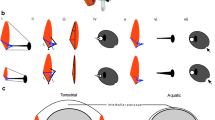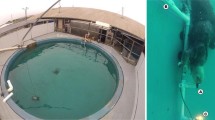Abstract
Animals exhibit unique hearing adaptations in relation to the habitat media in which they reside. This study was a comparative analysis of auditory specialization in relation to habitat medium in Testudines, a taxon that includes both highly aquatic and fully terrestrial members. Evoked potential audiograms were collected in four species groups representing diversity along the aquatic–terrestrial spectrum: terrestrial and fossorial Gopherus polyphemus, terrestrial Terrapene carolina carolina, and aquatic Trachemys scripta and Sternotherus (S. odoratus and S. minor). Additionally, underwater sensitivity was tested in T. c. carolina, T. scripta, and Sternotherus with tympana submerged just below the water surface. In aerial audiograms, T. c. carolina were most sensitive, with thresholds 18 dB lower than Sternotherus. At 100–300 Hz, thresholds in T. c. carolina, G. polyphemus, and T. scripta were similar to each other. At 400–800 Hz, G. polyphemus thresholds were elevated to 11 dB above T. c. carolina. The underwater audiograms of T. c. carolina, T. scripta, and Sternotherus were similar. The results suggest aerial hearing adaptations in emydids and high-frequency hearing loss associated with seismic vibration detection in G. polyphemus. The underwater audiogram of T. c. carolina could reflect retention of ancestral aquatic auditory function.



Similar content being viewed by others
References
Adrian ED, Craik KJW, Sturdy RS (1938) The electrical response of the auditory mechanism in cold-blooded vertebrates. Proc R Soc Biol 125:435–455
Bass AH, Clark CW (2003) The physical acoustics of underwater sound communication. In: Simmons AM, Fay RR, Popper AN (eds) Acoustic communication. Springer, New York, pp 15–64
Bowles AE, Eckert S, Starke L, Berg E, Wolski L (1999) Effects of flight noise from jet aircraft and sonic booms on hearing, behavior, heart rate and oxygen consumption of desert tortoises (Gopherus agassizii). DTIC Document, Hubbs-Sea World Research Institute, San Diego
Bramble DM (1982) Scaptochelys: generic revision and evolution of gopher tortoises. Copeia 1982:852–867. doi:10.2307/1444097
Bramble DM, Hutchison JH (2014) Morphology, taxonomy, and distribution of north american tortoises: an evolutionary perspective. In: Rostal DC, McCoy ED, Mushinsky HR (eds) Biology and conservation of North American tortoises. Johns Hopkins University Press, Baltimore, pp 1–12
Christensen CB, Christensen-Dalsgaard J, Madsen PT (2015) Hearing of the African lungfish (Protopterus annectens) suggests underwater pressure detection and rudimentary aerial hearing in early tetrapods. J Exp Biol 218:381–387. doi:10.1242/jeb.116012
Christensen-Dalsgaard J, Elepfandt A (1995) Biophysics of underwater hearing in the clawed frog, Xenopus laevis. J Comp Physiol A 176:317–324. doi:10.1007/BF00219057
Christensen-Dalsgaard J, Manley GA (2014) The malleable middle ear: an underappreciated player in the evolution of hearing in vertebrates. In: Köppl C, Manley GA, Popper AN, Fay RR (eds) Insights from comparative hearing research: Springer Handbook of Auditory Research. Springer, New York, pp 157–191
Christensen-Dalsgaard J, Brandt C, Wilson M et al (2011) Hearing in the African lungfish (Protopterus annectens): pre-adaptation to pressure hearing in tetrapods? Biol Lett 7:139–141. doi:10.1098/rsbl.2010.0636
Christensen-Dalsgaard J, Brandt C, Willis KL, Christensen CB, Ketten D, Edds-Walton P, Fay RR, Madsen P, Carr CE (2012) Specialization for underwater hearing by the tympanic middle ear of the turtle, Trachemys scripta elegans. Proc R Soc B 279:2816–2824. doi:10.1098/rspb.2012.0290
Endler JA (1992) Signals, signal conditions, and the direction of evolution. Am Nat 140:126–148
Ernst CH, Barbour RW (1972) Turtles of the United States. The University Press of Kentucky, Lexington
Ferrara CR, Mortimer JA, Vogt RC (2014a) First evidence that hatchlings of Chelonia mydas emit sounds. Copeia 2014:245–247. doi:10.1643/CE-13-087
Ferrara CR, Vogt RC, Giles JC, Kuchling G (2014b) Chelonian vocal communication. In: Witzany G (ed) Biocommunication of animals. Springer, Dordrecht, pp 261–274
Galeotti P, Sacchi R, Rosa DP, Fasola M (2005) Female preference for fast-rate, high-pitched calls in Hermann’s tortoises Testudo hermanni. Behav Ecol 16:301–308
Giles JC, Davis JA, McCauley RD, Kuchling G (2009) Voice of the turtle: the underwater acoustic repertoire of the long-necked freshwater turtle, Chelodina oblonga. J Acoust Soc Am 126:434–443. doi:10.1121/1.3148209
Hetherington T (2008) Comparative anatomy and function of hearing in aquatic amphibians, reptiles, and birds. In: Thewissen JGM, Nummela S (eds) Sensory evolution on the threshold: adaptations in secondarily aquatic vertebrates. University of California Press, Berkeley, pp 183–209
Hetherington TE, Lombard RE (1982) Biophysics of underwater hearing in anuran amphibians. J Exp Biol 98:49–66
Higgs D, Bittan-Powell E, Soares D, Souza M (2002) Amphibious auditory responses of the American alligator (Alligator mississippiensis). J Comp Physiol A 188:217–223
Joyce WG, Gauthier JA (2004) Palaeoecology of Triassic stem turtles sheds new light on turtle origins. Proc R Soc Lond B 271:1–5. doi:10.1098/rspb.2003.2523
Kastak D, Schusterman RJ (1998) Low-frequency amphibious hearing in pinnipeds: methods, measurements, noise, and ecology. J Acoust Soc Am 103:2216–2228. doi:10.1121/1.421367
Lenhardt ML (1981) Evidence for auditory localization ability in the turtle. J Audit Res 21:255–261
Lenhardt ML (1982) Bone conduction hearing in turtles. J Audit Res 22:153–160
Lenhardt M, Klinger R, Musick J (1985) Marine turtle middle-ear anatomy. J Audit Res 25:66–72
Lester LA (2012) Direct and indirect effects of recreational boats on diamondback terrapins (Malaclemys terrapin). Dissertation, Drexel University
Martin KJ, Alessi SC, Gaspard JC, Tuker AD, Bauer GB, Mann DA (2012) Underwater hearing in the loggerhead turtle (Caretta caretta): a comparison of behavioral and auditory evoked potential audiograms. J Exp Biol 215:3001–3009. doi:10.1242/jeb.066324
Mason MJ (2013) Of mice, moles and guinea pigs: functional morphology of the middle ear in living mammals. Hear Res 301:4–18. doi:10.1016/j.heares.2012.10.004
Mason MJ, Narins PM (2001) Seismic signal use by fossorial mammals. Am Zool 41:1171–1184. doi:10.1093/icb/41.5.1171
Mount RH (1996) The reptiles and amphibians of alabama. The University of Alabama Press, Tuscaloosa
Parvulescu A (1967) The acoustics of small tanks. In: Tavolga WN (ed) Marine bioacoustics 2. Pergamon Press Ltd., Oxford, pp 7–13
Piniak WED (2012) Acoustic ecology of sea turtles: implications for conservation. Dissertation, Duke University
Popper AN, Fay RR (2011) Rethinking sound detection by fishes. Hear Res 273:25–36. doi:10.1016/j.heares.2009.12.023
Reichmuth C, Holt MM, Mulsow J et al (2013) Comparative assessment of amphibious hearing in pinnipeds. J Comp Physiol A 199:491–507. doi:10.1007/s00359-013-0813-y
Shaffer H (2009) Turtles (Testudines). In: Hedges SB, Kumar S (eds) The timetree of life. Oxford University Press, Oxford, pp 398–401
Stevens M (ed) (2013) Sensory systems: trade-offs, costs, and sensory integration. In: Sensory ecology, behaviour, and evolution. Oxford University Press. Oxford, pp 55–69
Thewissen JGM, Nummela S (2008) Sensory evolution on the threshold: adaptations in secondarily aquatic vertebrates. University of California Press, Berkeley
Wever EG (1978) The reptile ear. Princeton University Press, Princeton
Willis KL, Christensen-Dalsgaard J, Ketten DR, Carr CE (2013) Middle ear cavity morphology is consistent with an aquatic origin for Testudines. PLoS One 8:e54086. doi:10.1371/journal.pone.0054086
Young BA, Mathevon N, Tang Y (2014) Reptile auditory neuroethology: What do reptiles do with their hearing? In: Köppl C, Manley GA, Popper AN, Fay RR (eds) Insights from comparative hearing research: Springer Handbook of Auditory Research. Springer, New York, pp 323–346
Acknowledgments
We thank members of the Guyer and Johnston labs for assistance in capturing turtles and J. Goessling for providing access to G. polyphemus. All applicable international, national, and institutional guidelines for the care and use of animals were followed. JNZ received funding from a graduate student grant from Auburn University.
Author information
Authors and Affiliations
Corresponding author
Rights and permissions
About this article
Cite this article
Zeyl, J.N., Johnston, C.E. Amphibious auditory evoked potentials in four North American Testudines genera spanning the aquatic–terrestrial spectrum. J Comp Physiol A 201, 1011–1018 (2015). https://doi.org/10.1007/s00359-015-1031-6
Received:
Revised:
Accepted:
Published:
Issue Date:
DOI: https://doi.org/10.1007/s00359-015-1031-6




